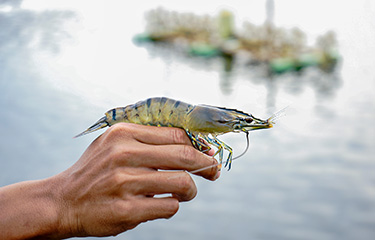A shift back to black tiger shrimp farming, and away from vannamei – which is becoming more prone to disease and more costly to farm – is under way in Asia. But whether the market is willing to consume the increased volume, at higher price levels, remains a question.
One of the main themes discussed at the inaugural Global Shrimp Forum (GSF) – which took place in Utrecht, The Netherlands, from 6 to 8 September – was the ongoing revival of black tiger shrimp farming in Asia and whether this expansion will be welcomed by the market, according to the latest blog by analyst Willem van der Pijl, the founder of consultancy Shrimp Insights and the managing director of the GSF Foundation, which organized the event.
According to van der Pijl, vannamei farming has become more difficult as competition increases, with lower selling prices and higher production costs. In this context, only big players who are capable of investing in advanced technologies and equipment for their farming operations can survive. For a large number of the rest, mostly small-scale producers, vannamei production may be no longer feasible.
“An alternative strategy to continue making a living of shrimp farming could be for these farmers to start cultivating black tiger shrimp,” he said.
Van der Pijl said industry opinion expressed at the forum made him believe the growth of black tiger shrimp farming was the key trend to watch in the shrimp industry. This resurrection will be backed by the development of domestic specific pathogen-free shrimp genetics and improvements in the required infrastructure, such as broodstock multiplication centers and hatcheries, in China, India, Indonesia, and Vietnam.
Charoen Pokphand Foods (CPF) Senior Vice President Robins McIntosh said many Asian farmers, who are struggling with the capital-intensive production of vannamei, have begun to farm more black tiger shrimp mainly thanks to the breeding programs undertaken by CPF and Moana Technologies. The two companies have achieved postlarvae growth and survival comparable to any Pacific white shrimp breeding scheme, he said. McIntosh called the black tiger shrimp the “poor farmer’s shrimp” because the animals can grow relatively fast and suffer from fewer diseases than vannamei, resulting in lower farming costs.
McIntosh said global production of black tiger shrimp rose to 546,000 metric tons (MT) in 2021 from 382,000 MT in 2019. China, where CPF accounts for about 85 percent of the postlarvae market, will produce an estimated 180,000 MT of black tiger shrimp in 2022, up 20 percent from 2021, possibly surpassing Vietnam as the largest producer of the shrimp species in the world, he said.
In India, Vaishnavi Aquatech, which is owned by the family of Dhaval Contractor – another speaker at the GSF – began importing domesticated black tiger broodstock from Moana for production in 2021. The contractor family operates six hatcheries across India, which have collectively produced more than one billion postlarvae.
Vaishnavi Aquatech recently expanded by building a government-accredited broodstock multiplication center, which Willem van der Pijl believes will be “the main enabler of further growth of India’s black tiger shrimp production” in the coming years. Vaishnavi Aquatech’s adult broodstock, which are produced from parent postlarvae imported from Moana’s headquarters in the U.S. state of Hawaii, will be used to produce F1 generation broodstock. The contractor hopes to see a doubling of India’s farming area of black tiger shrimp to 130,000 hectares in the fiscal year 2026-2027 from its current level, and an expansion of India’s black tiger shrimp production to around 455,000 MT in 2026-2027 from 220,000 MT in 2022-2023.
“When he presented this number at the GSF last September, the audience was shocked,” van der Pijl said.
Many farmers in Gujarat, Andhra Pradesh, Odisha, and West Bengal are likely to switch from vannamei to black tiger shrimp farming, especially those who have struggled with the recent rise in operational costs of vannemei production, according to van der Pijl.
In Indonesia, which currently touts a modest output of around 50,000 MT of black tiger shrimp from a total farming area of 300,000 hectares, Bong Tiro, a co-owner of a number of vannemei hatcheries, is also working on a plan to bring domesticated black tiger shrimp to local farmers. Tiro said black tiger shrimp production in Indonesia can only grow if more postlarvae are made more readily available to local farmers. After several farming trials using Moana’s genetics, Bong Tiro built his own small broodstock multiplication centers in several of Indonesia’s key farming areas to supply breeders and nauplii to his company’s own hatcheries and other jointly operated facilities. He recently purchased three batches of parent postlarvae from Moana to stock his own broodstock multiplication center in Indonesia, and he now aims to sell postlarvae in three locations in Indonesia by the end of the year.
However, across Asia, the shift back to black tiger shrimp is dependent on the willingness of customers to pay higher prices. In China, consumption of black tiger shrimp is not a big problem because it is believed to have a superior taste and appearance, and can therefore be sold as a premium fresh product. The U.S. and Northern Europe were previously major destinations for black tiger shrimp, along with Japan and the Middle East, but switched their preference to vannamei as that became the dominant shrimp species available around 15 years ago. It will be necessary for Asian black tiger shrimp producers to regain market share in those regions in order to remain viable, Jeff Stern, co-president of Censea, the largest black tiger shrimp importer and distributor in the U.S., said at GSF.
Black tiger shrimp is still sold into Europe, but is mostly consumed in the foodservice sector in Northern Europe and through a few retailers in Belgium and Germany. France, where OSO and Unima have had success exporting black tiger shrimp grown in Madagascar, may not be a big enough market for Asian exporters to target, as it currently consumes less than 6,000 MT of black tiger shrimp annually.
And in Asia’s own foodservice sector, where black tiger shrimp has long been popular, Heiko Lenk and Rogier Speelman of Lenk Frozen Foods and Fisherman’s Choice warned at GSF if the price difference between the black tiger shrimp and vannamei exceeds USD 1.00 (EUR 1.03) per kilogram, consumers will generally choose the latter.
Even if the price difference is kept at below USD 1.00 per kilogram, the U.S. and Northern Europe alone are unable to absorb a volume of more than 500,000 MT, van der Pijl said.
“While acknowledging that we will likely see a surge of black tiger shrimp production in India and Indonesia, the resurrection might be very short-lived if the producers, feed companies, processors, and their overseas buyers don’t work together to develop the market,” van der Pijl said. “For the revival of black tiger shrimp to be successful, we may not only need to look at the suitable farmer-system-species combination but extend it with the right specification-market combination.”
Photo courtesy of Mati Nitibhon/Shutterstock







